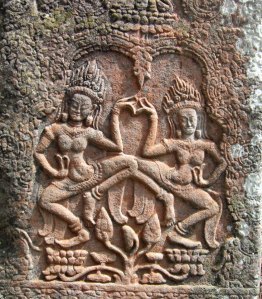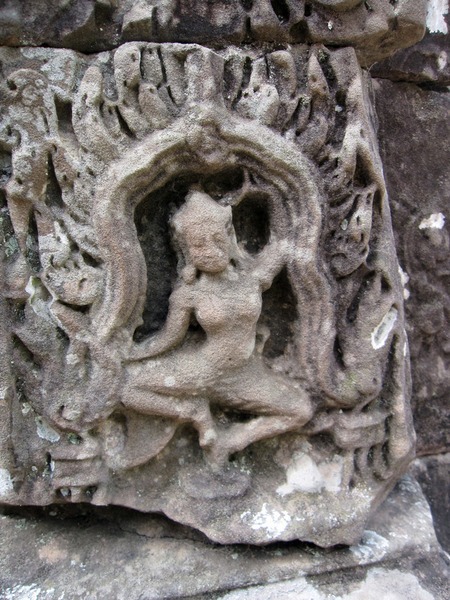新規記事の投稿を行うことで、非表示にすることが可能です。
2017年09月08日
PERFECT SUNSET 60min 4K (Ultra HD)
PERFECT SUNSET 60min 4K (Ultra HD)
PERFECT SUNSET 60min 4K (Ultra HD)
https://youtu.be/jEnd8JIMii4
Published on Oct 19, 2014
Learn more about this place
http://kagoshima-kankou.com/Kagoshima...
PERFECT SUNSET 60min 4K (Ultra HD)
https://youtu.be/jEnd8JIMii4
Published on Oct 19, 2014
Learn more about this place
http://kagoshima-kankou.com/Kagoshima...
[Japan] Tribute to Dr. Philipp Franz Balthasar von Siebold
[Japan] Tribute to Dr. Philipp Franz Balthasar von Siebold
[Japan] Tribute to Dr. Philipp Franz Balthasar von Siebold
https://youtu.be/0YM6hNhePFs
Published on Feb 18, 2015
This video tries to show u the life's story of Dr. Philipp Franz Balthasar von Siebold, a Bavarian/German noble origin who came to Japan in 1823... in the Edo period of Japan. At the time, Japan traded only with Dutch through an artificial island called, "De.ji.ma."
From this story though, one can see that there were non-Dutch people trying to enter Japan no matter what the cost. In Japan, Siebold's story is well known but he is described as "Dutch."
It is truly amazing to learn that Samurais spoke fluent Dutch and detected that Philipp was not Dutch. Philipp's daughter, Ine, was also fluent in Dutch but Philipp spoke Japanese with his family in Japan.
It is also amazing to learn that Philipp was actually from a long line of Bavarian noble origin and his family as well as extended families are extremely well-to-do, producing the first female medical doctor in not only Germany but also Japan.
While in Japan, Philipp actually had two children, Ine with Taki and another child. Ine is very well known but another child... no one knows what happened to this person. The child was born when Philipp was in the 60s and the mother was a Japanese woman who worked as a maid in Dejima...so it is said.
In any rate, it is indeed a fascinating story of Japanese history.
Enjoy and many thanks for watching... ; D
Don't forget to give a big thumbs up and subscribe.
Correction to this video) The von Siebold Memorial Garden is not in Nagasaki but in Leiden, the Netherlands.
Category People & Blogs
License Standard YouTube License
~~~~~~~~~~~~~~~~~~~~~~~~~~~~
Philipp Franz Balthasar von Siebold
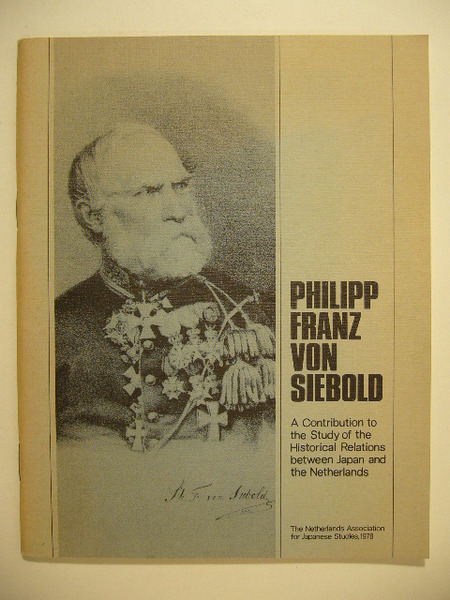
☆NOTE☆
"Philipp Franz von Siebold" :Wikipedia
https://en.wikipedia.org/wiki/Philipp_Franz_von_Siebold
"De.ji.ma.":
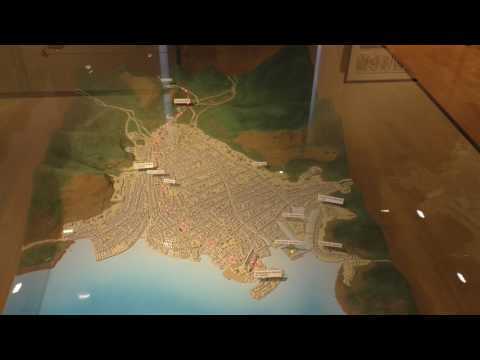
http://reloadyoutube.com/inc/_related.php?id=OBqgISytP1E
https://www.youtube.com/watch?v=1u-pJgXJrwY
Published on Apr 30, 2017
Das Siebolmuseum Würzburg zeigt den Würzburger Forscher Philipp Franz von Siebold (1796-1866), seine Familie und dessen Wirken in Japan. Zudem gibt es immer wieder Sonderaustellungen rund um das Thema Japan. Das Museum steht auf den ehemaligen Bürgerbräu Gelände Frankfurter Str. 87 97082 Würzburg und wird von der Siebold-Gesellschaft betreut.
Homepage: https://siebold-museum.byseum.de/
Category News & Politics
License Standard YouTube License
===================================================
===================================================
[Japan] Tribute to Dr. Philipp Franz Balthasar von Siebold
https://youtu.be/0YM6hNhePFs
Published on Feb 18, 2015
This video tries to show u the life's story of Dr. Philipp Franz Balthasar von Siebold, a Bavarian/German noble origin who came to Japan in 1823... in the Edo period of Japan. At the time, Japan traded only with Dutch through an artificial island called, "De.ji.ma."
From this story though, one can see that there were non-Dutch people trying to enter Japan no matter what the cost. In Japan, Siebold's story is well known but he is described as "Dutch."
It is truly amazing to learn that Samurais spoke fluent Dutch and detected that Philipp was not Dutch. Philipp's daughter, Ine, was also fluent in Dutch but Philipp spoke Japanese with his family in Japan.
It is also amazing to learn that Philipp was actually from a long line of Bavarian noble origin and his family as well as extended families are extremely well-to-do, producing the first female medical doctor in not only Germany but also Japan.
While in Japan, Philipp actually had two children, Ine with Taki and another child. Ine is very well known but another child... no one knows what happened to this person. The child was born when Philipp was in the 60s and the mother was a Japanese woman who worked as a maid in Dejima...so it is said.
In any rate, it is indeed a fascinating story of Japanese history.
Enjoy and many thanks for watching... ; D
Don't forget to give a big thumbs up and subscribe.
Correction to this video) The von Siebold Memorial Garden is not in Nagasaki but in Leiden, the Netherlands.
Category People & Blogs
License Standard YouTube License
~~~~~~~~~~~~~~~~~~~~~~~~~~~~
Philipp Franz Balthasar von Siebold

☆NOTE☆
"Philipp Franz von Siebold" :Wikipedia
https://en.wikipedia.org/wiki/Philipp_Franz_von_Siebold
"De.ji.ma.":

http://reloadyoutube.com/inc/_related.php?id=OBqgISytP1E
https://www.youtube.com/watch?v=1u-pJgXJrwY
Published on Apr 30, 2017
Das Siebolmuseum Würzburg zeigt den Würzburger Forscher Philipp Franz von Siebold (1796-1866), seine Familie und dessen Wirken in Japan. Zudem gibt es immer wieder Sonderaustellungen rund um das Thema Japan. Das Museum steht auf den ehemaligen Bürgerbräu Gelände Frankfurter Str. 87 97082 Würzburg und wird von der Siebold-Gesellschaft betreut.
Homepage: https://siebold-museum.byseum.de/
Category News & Politics
License Standard YouTube License
===================================================
Philipp Franz Balthasar von Siebold,
— Ise-no-Kamikaze (@matuoka7ocean) 2017年9月8日
Note "https://t.co/qc7uWsCHPR."https://t.co/Zj8wQQiNIa
Das Sieboldmuseum - -https://t.co/oLZVgandqg
===================================================
Parkinson's and Kangen water 1, 2
Parkinson's and Kangen water 1
Parkinson's and Kangen water 1
https://youtu.be/h1RiuYxP8eE
===================================================
Parkinson's and Kangen Water 2
Parkinson's and Kangen Water 2
https://youtu.be/0Am138A-B10
===================================================
===================================================
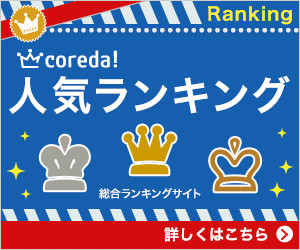

===================================================
===================================================
Parkinson's and Kangen water 1
https://youtu.be/h1RiuYxP8eE
===================================================
Parkinson's and Kangen Water 2
Parkinson's and Kangen Water 2
https://youtu.be/0Am138A-B10
===================================================
===================================================
===================================================
===================================================
2017年09月07日
Hydrogen Rich water helps in the treatment of Parkinson's Disease in Rats
Hydrogen Rich water helps in the treatment of Parkinson's Disease in Rats
https://youtu.be/5pwz1SqVzPw
Published on Sep 20, 2016
Category People & Blogs
License Standard YouTube License
~~~~~~~~~~~~~~~~~~~~~~~~~~~~
☆NOTE☆
"Parkinson's disease" :Wikipedia
https://en.wikipedia.org/wiki/Parkinson%27s_disease
"パーキンソン病" :Wikipedia
https://ja.wikipedia.org/wiki/%E3%83%91%E3%83%BC%E3%82%AD%E3%83%B3%E3%82%BD%E3%83%B3%E7%97%85
☆ Reference Link☆:
Hydrogen Rich water effect to Parkinson's disease
1. “Oral ‘hydrogen water’ induces neuroprotective ghrelin secretion in mice”
Akio Matsumoto, Megumi Yamafuji, Tomoko Tachibana, Yusaku Nakabeppu, Mami Noda & Haruaki Nakaya
https://www.nature.com/articles/srep03273
Abstract
The therapeutic potential of molecular hydrogen (H2) is emerging in a number of human diseases and in their animal models, including in particular Parkinson's disease (PD). H2 supplementation of drinking water has been shown to exert disease-modifying effects in PD patients and neuroprotective effects in experimental PD model mice. However, H2 supplementation does not result in detectable changes in striatal H2 levels, indicating an indirect effect. Here we show that H2 supplementation increases gastric expression of mRNA encoding ghrelin, a growth hormone secretagogue, and ghrelin secretion, which are antagonized by the β1-adrenoceptor blocker, atenolol. Strikingly, the neuroprotective effect of H2 water was abolished by either administration of the ghrelin receptor-antagonist, D-Lys3 GHRP-6, or atenolol. Thus, the neuroprotective effect of H2 in PD is mediated by enhanced production of ghrelin. Our findings point to potential, novel strategies for ameliorating pathophysiology in which a protective effect of H2 supplementation has been demonstrated.
Introduction
Therapeutic applications of molecular hydrogen (H2) have been reported in a variety of human diseases and their animal models1, including ischemia-reperfusion injury2,3,4, metabolic syndrome5, diabetes mellitus type 26, organ transplantation7,8,9, reduction of adverse effects of anti-tumor drug therapy10,11 and radiation therapy12,13. Although the mechanism of action of H2 has not been clearly demonstrated, it is assumed that its anti-oxidative properties, particularly against hydroxyl radical (・OH) and peroxinitrite (ONOO−), are likely to underlie therapeutic efficacy2. Unlike other medical-gas therapy, H2 can be applied in air for inhalation or in solution for drinking, intravenous injection or dialysis. Whereas intravenous injection or dialysis delivers H2 directly into the blood stream, oral hydrogen-supplemented water (hydrogen water, H2-water) must be absorbed into the circulation resulting in limited H2 concentrations in the blood and in target organs7,14.
Parkinson's disease (PD) has been a major focus in the field of oxidative stress and disease, because it is thought that degeneration of dopaminergic neurons can be triggered and aggravated by the accumulation of oxidative damage. However, although antioxidant therapies have been assessed in PD patients, clinical efficacy has not been established15,16. In contrast, a pilot study of hydrogen water therapy in PD patients has shown promising results17, and it has been reported that hydrogen water exhibits neuroprotective effects14 in the murine MPTP (1-methyl-4-phenyl-1,2,3,6-tetrahydropyridine)-induced PD model18. H2 levels were below measurable thresholds in the substantia nigra in PD model mice14, and hydrogen water, but not continuous inhalation of 2% H2, prevented the development of PD in a rat model19. These findings suggest that the therapeutic effects of hydrogen water may not require its anti-oxidant activity in the brain, and further that its efficacy requires processing that is consequent upon oral administration.
The purpose of the present study was to employ PD model mice to elucidate the underlying mechanism of the neuroprotective effects of oral H2-water. In particular, we hypothesized that oral H2 induces a messenger molecule, which travels to the brain and exerts neuroprotective activity.
Results
Oral hydrogen water induces ghrelin gene expression in the stomach
The stomach functions as an endocrine organ that secretes various peptide hormones with a broad range of physiological effects. We first focused on the stomach to investigate possible effects of oral H2-water at the level of gene induction. In a previous study14, it was reported that drinking H2-water for a period of 7 days prior to MPTP injection protected against MPTP toxicity. We administered oral H2-water for 4 consecutive days and analyzed expression in stomach tissue of gastrin, somatostatin, and ghrelin by real-time PCR method. Levels of ghrelin mRNA increased 1.9-fold in H2-water-treated versus control mice (Figure 1), whereas no effects of hydrogen water were detected on expression of the somatostatin gene (expressed only at trace levels) or the gastrin gene (expression of which was highly variable from individual to individual) (not shown).
Figure 1: Oral H2 water increases ghrelin gene expression in the mouse stomach.
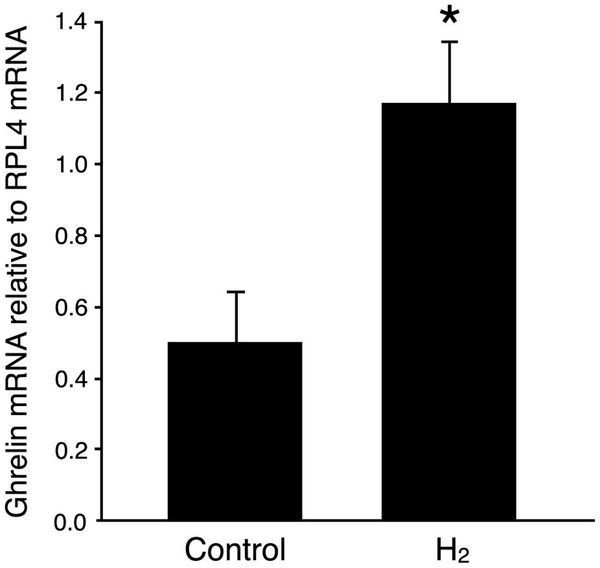
Control water, or H2 water (0.8ml/mouse) made with a stick of magnesium (about 0.04mM H2; see Methods), was administered to mice (41–48 weeks of age; n = 4 per group) once a day for 4 days. Three hr after the final ingestion, the stomach was removed and prepared for qPCR. Data were normalized with respect to expression of RPL4 mRNA and are represented as mean ± SEM.
To examine the time-course of ghrelin induction by hydrogen water, mice were administered hydrogen water or control water once a day for 0 (control) 1, 2 or 4 days and ghrelin levels were measured by ELISA in plasma derived from blood obtained 4–5hours after the final administration of H2- or control water. Only mice that received H2 water for 4-day exhibited a significant increase in plasma ghrelin level, although mice administered hydrogen water for 2-day showed a non-significant increase (Figure 2).
Figure 2: Plasma ghrelin levels following administration of oral H2 water.
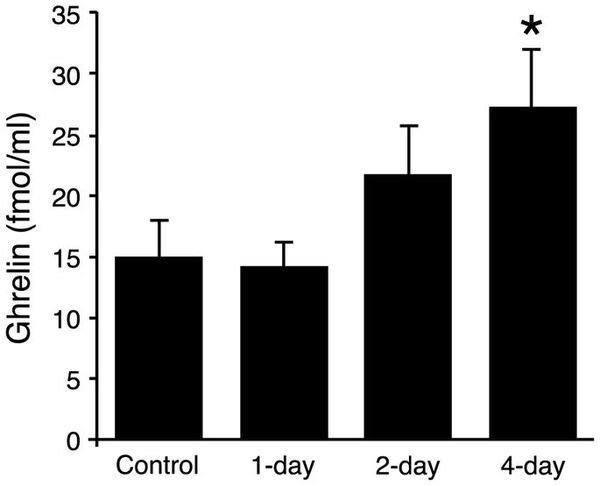
Mice (16–21 weeks, average 18.5 weeks, n = 5–10) received H2 water (or control water) as in Fig. 1 for 1, 2 or 4d. Blood was collected on the final day of the experiment, 4hr after the last ingestion, and plasma levels of ghrelin were quantified by ELISA. Panel shows data from male mice. The ghrelin level was significantly higher only in the group of mice drinking H2 water for 4d. Data are represented as mean ± SEM.
Mice (16–21 weeks, average 18.5 weeks, n = 5–10) received H2 water (or control water) as in Fig. 1 for 1, 2 or 4d. Blood was collected on the final day of the experiment, 4hr after the last ingestion, and plasma levels of ghrelin were quantified by ELISA. Panel shows data from male mice. The ghrelin level was significantly higher only in the group of mice drinking H2 water for 4d. Data are represented as mean ± SEM.
β1-adrenergic receptor signaling mediates enhancement of ghrelin secretion by oral hydrogen water
It has been shown that gastric secretion of ghrelin is regulated by local environmental cues including blood glucose, estrogen, insulin and catecholamines20,21,22. In particular, it has been reported that β1-adrenergic receptor stimulation increases ghrelin secretion in vitro and in vivo22,23. We verified the expression of β1- and β2- adrenergic receptors in stomach tissue samples by real-time PCR method, and determined that there were no significant changes in the levels of expression after administration of oral H2-water for 4 days (data not shown). The increase in plasma ghrelin levels by oral hydrogen water was eliminated by administration of the β1-adrenergic receptor-specific blocker, atenolol (10mg/kg i.p.) injected 30min prior to H2 water administration on each of four days (Figure 3). Thus, activation of β1-adrenergic receptors is required for hydrogen water-induced enhancement of circulating ghrelin.
Figure 3: H2 water increases plasma ghrelin levels in a β1-adrenergic receptor-dependent manner.
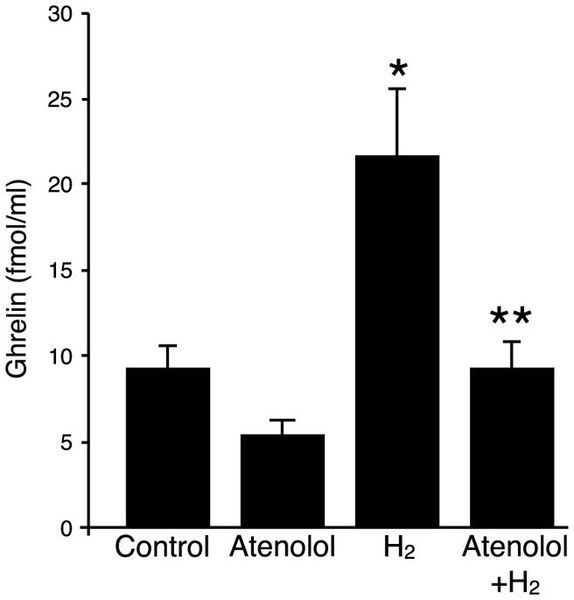
Plasma ghrelin levels were measured on the last day of experiment. Each group of mice (11–13 weeks of age; n = 4–5 for each group) was administered control water or H2 water (made with an open-air water electrolysis system) once a day for 4d with or without i.p. injection of atenolol (10mg/kg) prior to water ingestion. The H2 water group showed a significant increase in plasma ghrelin level compared to the control group (* p = 0.038), which was abrogated by pretreatment with atenolol (** p = 0.039). Datafare represented as mean ± SEM.
Blockades of ghrelin action abrogates the protective effect of H2 water in PD model mice
In a previous report, oral H2-water exhibited significant protective effects in MPTP-induced PD model mice against the loss of dopaminergic neurons from the substantia nigra14. To test directly the role of ghrelin, either the growth hormone secretagogue receptor antagonist, D-Lys3 GHRP-6 (100nmol/day i.p.), or β1-adrenoceptor blocker, atenolol (10mg/kg i.p.), was administered along with control or hydrogen water for 7 days prior to administration of MPTP. Loss of dopaminergic neurons from the substantia nigra was evaluated seven days following administration of MPTP. As shown in Figure 4, systemic administration of MPTP caused a significant loss of dopaminergic neurons from the pars compacta of the substantia nigra (SNpc) as assessed by immunohistochemical detection of tyrosine hydroxylase (TH) (a), and further confirmed by immunological detection of TH protein in the substantia nigra with actin as control (b), and stereological analysis (c). Whereas administration of H2 water alone in control mice had no effect, the loss of dopaminergic neurons in MPTP-treated mice was significantly decreased by administration of hydrogen water, as previously reported14. Strikingly, although administration of D-Lys3 GHRP-6 or atenolol in control mice had no effect alone and D-Lys3 GHRP-6 or atenolol did not affect MPTP-induced loss of dopaminergic neurons, the protective effects of hydrogen water were eliminated by either one of D-Lys3 GHRP-6 or atenolol. Thus, induction of gastric ghrelin production and subsequent activation of ghrelin-initiated signal transduction underlies the protective effects of hydrogen water in the MPTP model of PD.
Figure 4: Inhibition of ghrelin secretion or the ghrelin receptor antagonist cancels the neuroprotective effect of oral H2 water in MPTP-induced Parkinson's disease model mice (male, 8–12 weeks, n = 2–5 for each group).
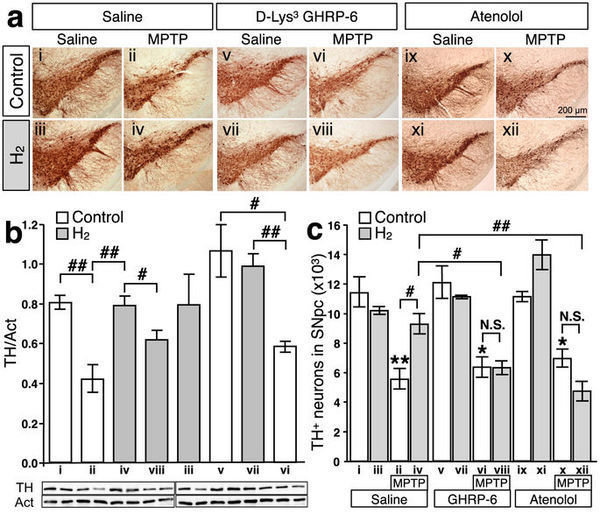
Saturated H2 water was made daily as described in materials and methods. (a): Tyrosine hydroxylase (TH) staining was performed in substantia nigra pars compacta from saline-injected (i–iv), D-Lys3 GHRP-6-injected (v–viii), and atenolol-injected (ix–xii) mice, supplied with either normal tap water (control) or H2 water for 7 days. MPTP was injected (i.p.) after 7 days of D-Lys3 GHRP-6, atenolol, or saline-injection (ii, iv, vi, viii, x, and xii). (b): Summary of the immunoblotting analysis of TH protein in the substantia nigra tissue (n = 3–6 for each group) and the representative blot images were shown underneath (two samples per group). The TH band intensity was normalized to the band of actin on the same sample. (## p = 0.007, i vs. ii; 0.010, ii vs. iv; 0.004, vi vs. vii; # p = 0.043, iv vs. viii; 0.023, v vs. vi). Data in figures are represented as mean ± SEM. (c): Summary of the stereological analysis of nigral dopaminergic neurons. Although MPTP injections caused significant loss of TH-positive neurons (ii) (** p = 0.0001, i vs. ii), drinking H2 water for 7 days prior to MPTP-treatment significantly attenuates the loss of TH-positive cells (iv) (# p = 0.008, ii vs. iv). D-Lys3 GHRP-6, growth hormone secretagogue receptor antagonist, or β1-adrenoceptor blocker, atenolol, canceled the preservation effect of oral H2 water (viii and xii) (# p = 0.008; ii vs. iv; p = 0.003, iv vs. viii; p = 0.0003, iv vs. xii). Data in figures are represented as mean ± SEM. The statistical significance of data was assessed by one-way ANOVA followed by Benferroni test.
Discussion
Our findings demonstrate that the neuroprotective effects of oral hydrogen water, which produces negligible levels of H2 in the brain, result from gastric induction of the neuroprotective peptide hormone ghrelin and the subsequent activation of ghrelin receptors. In addition, we have shown an obligate role for β1-adrenergic receptors in hydrogen water-induced ghrelin up-regulation in plasma, consistent with previous reports that adrenergic stimulation regulates ghrelin release in vitro and in vivo22,24,25.
The neuroprotective effects of ghrelin in PD are well-established26, and it has been demonstrated that the receptor for ghrelin, the growth hormone secretagogue receptor (GHSR), is highly expressed by dopaminergic neurons of the substantia nigra27. It has been suggested that ghrelin protects nigrostriatal dopamine neurons via an uncoupling protein 2 (UCP2)-dependent mitochondrial mechanism28,29. However, we found that the expression of neither UCP2 mRNA nor protein was significantly upregulated by administration of H2 water drinking for 7 days (data not shown). This finding suggests an alternative signaling mechanism downstream of GHSR activation, perhaps involving PI3K/Akt30.
It was reported that administration of saturated hydrogen water (approx. 0.8mM) led to symptomatic improvement in PD patients17. Administration of hydrogen water at about 0.05% saturation successfully maintained dopaminergic neurons in MPTP-induced PD model mice14. We employed three different methods to prepare hydrogen water (see Methods), which resulted in H2 concentration of 0.04–0.8mM, and we observed that the effects of hydrogen water on ghrelin induction and protection of dopamine neurons were dose-independent over this range. Thus, small amounts of oral H2 are sufficient for gastric induction of ghrelin and subsequent neuroprotection, in the absence of detectable H2 in the brain. Interestingly, gut microbes can produce molecular hydrogen constitutively and lactulose, a synthetic disaccharide, is an effective substrate to enhance bacterial H2 production in the colon31. However, ingestion of lactulose had no significant effect on dopaminergic neuron survival in 6-OHDA-induced PD model rats (although alveolar H2 concentrations were elevated)19. These results emphasize the importance of gastric ghrelin induction in the neuroprotective action of H2. Oral H2-water is being explored as a therapeutic for PD as well as a variety of other human pathophysiological conditions17,32,33 under the generally held assumption that the mechanism of action of supplemental H2 is likely to reflect an antioxidative role. Our findings that oral H2 water exerts a neuroprotective effect through activation of an endogenous, gastric ghrelin system that is tightly coupled to β-adrenergic receptor signaling suggests the possibility of novel applications of H2 therapy for various diseases.
The rest is omitted.
〜〜〜〜〜〜〜〜〜〜
〜〜〜〜〜〜〜〜〜〜
~~~~~~~~~~~~~~~~~~~~~~~~~~~~
☆ Reference Link☆:
Hydrogen Rich water effect to Parkinson's disease
2. Blog:
“We love to write and share information Hydrogen Rich Water, Water Filters, Water, and many other health-related issues”
http://www.californiahydrogenwater.com/blog/new-study-on-effects-of-h2-on-parkinsons-disease
New Study on Effects of H2 on Parkinson's Disease
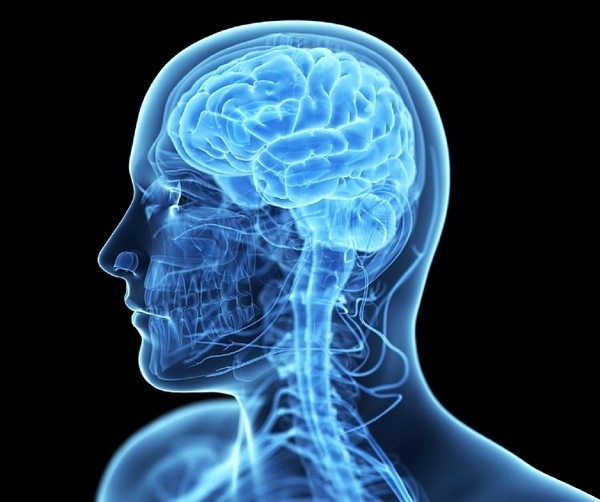
Here are the details of a new H2 study being conducted on people with Parkinson’s Disease. 178 individuals (89men/89 women average age 64.2 yrs.) in 14 different hospitals will be tested over the course of 72 weeks. Half will be given 1 liter of H2 water per day, half will drink regular water. Most of the patients are on levodopa which is used sometimes alone and sometimes with other drugs to hep with the symptoms of PD.
Previous studies have shown H2 to be of benefit with PD. This study is to confirm those findings with a “randomized double-blind placebo-controlled multi-center trial”.
Click here to read more
https://www.ncbi.nlm.nih.gov/pubmed/27176725
===================================================
===================================================
===================================================
===================================================
2017年09月06日
Google Ad
===================================================
===================================================
Google Ad
===================================================
===================================================
Google Ad Amazon
===================================================
===================================================
Google Ad
===================================================
===================================================
2017年08月28日
Angkor Wat: City Of The God Kings (Ancient Civilisations Documentary)
| Timeline
Angkor Wat: City Of The God Kings (Ancient Civilisations Documentary) | Timeline
https://youtu.be/KsDGDzwuQ-I
Angkor Wat: City Of The God Kings
(Ancient Civilisations Documentary) | Timeline
https://youtu.be/KsDGDzwuQ-I
Published on Jul 15, 2017
Lost Worlds investigates the very latest archaeological finds at three remote and hugely significant sites - Angkor Wat, Troy and Persepolis.
Lost Worlds travels to each site and through high-end computer graphics, lavish re-enactment and the latest archaeological evidence brings them to stunning televisual life. From the 900-year-old remains of Angkor Wat in the Cambodian jungle the staggering City of the God Kings is recreated. From Project Troia, in North West Turkey, the location of the biggest archaeological expedition ever mounted the lost city is stunningly visualised and finally from Persepolis the city and the great Persian Empire are brought to life.
Content licensed from Digital Rights Group (DRG).
Produced by Darlow Smithson Productions.
Category Education
License Standard YouTube License
~~~~~~~~~~~~~~~~~~~~~~~~~~~~
☆NOTE
1." Angkor Wat " :Wikipedia
https://en.wikipedia.org/wiki/Angkor_Wat
Abstract:
Angkor Wat (Khmer: អង្គរវត្ត or "Capital Temple") is a temple complex in Cambodia and the largest religious monument in the world, on a site measuring 162.6 hectares (1,626,000 m2; 402 acres).[1] It was originally constructed as a Hindu temple of god Vishnu for the Khmer Empire, gradually transforming into a Buddhist temple towards the end of the 12th century.[2] It was built by the Khmer King Suryavarman II[3] in the early 12th century in Yaśodharapura (Khmer: យសោធរបុរៈ, present-day Angkor), the capital of the Khmer Empire, as his state temple and eventual mausoleum. Breaking from the Shaiva tradition of previous kings, Angkor Wat was instead dedicated to Vishnu. As the best-preserved temple at the site, it is the only one to have remained a significant religious centre since its foundation. The temple is at the top of the high classical style of Khmer architecture. It has become a symbol of Cambodia,[4] appearing on its national flag, and it is the country's prime attraction for visitors.[5]
By Charles J Sharp - Taken from helicopter flying over Angkor Wat, CC BY 2.5, https://commons.wikimedia.org/w/index.php?curid=1317127
2." Apsara Angkor Wat " :Google Seach
https://www.google.co.jp/search?q=apsara+angkor+wat&rlz=1C1NHXL_jaJP727JP728&tbm=isch&tbo=u&source=univ&sa=X&ved=0ahUKEwi09fiX1vnVAhWGxbwKHWurDGIQsAQIZA&biw=1745&bih=864#imgrc=XloPXlKYQB5CgM:
~~~~~~~~~~~~~~~~~~~~~~~~~~~~
~~~~~~~~~~~~~~~~~~~~~~~~~~~~
Reference
Apsara - one of thousands of unique carvings of
khmer dancing girls in Angkor Wat, Cambodia, stock photo
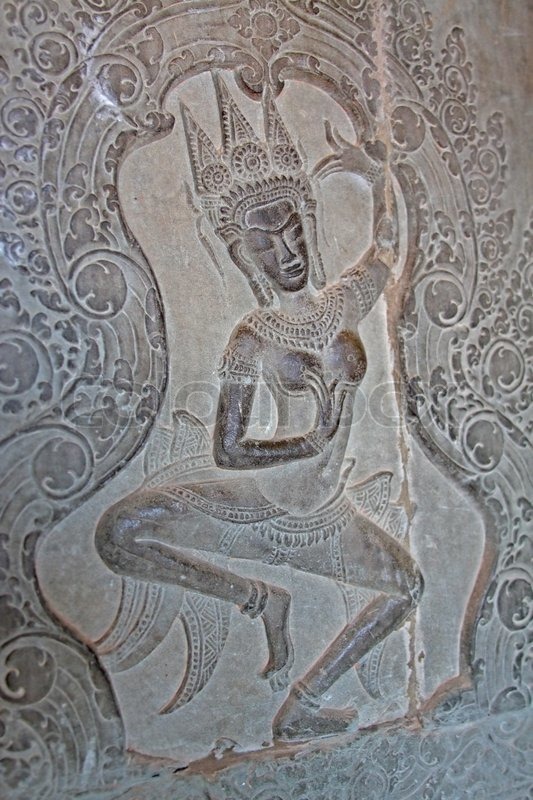
上記画像の出典リンク:
https://www.colourbox.com/image/apsara-one-of-thousands-of-unique-carvings-of-khmer-dancing-girls-in-angkor-wat-cambodia-image-3429870
~~~~~~~~~~~~~~~~~~~~~~~~~~~~
Hunting Apsaras through the Heat and Dust
The source Link:
https://traceyrohrsheim.com/tag/apsara/
[ Following extract ]
Hunting Apsaras through the Heat and Dust
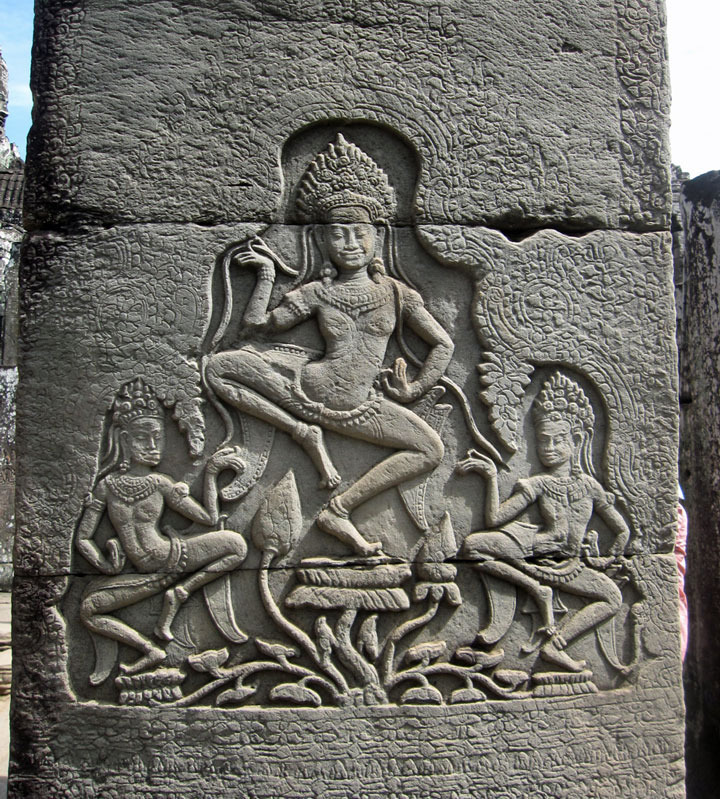
Of course, they are everywhere in Cambodia. Apsara hotels, apsara restaurants, apsara bookshops, hair salons, spas, art galleries, cafes.
Even the Cambodian government body looking after Angkor heritage sites is called APSARA (Authority for the Protection and Management of Angkor and the Region of Siem Reap). An apsara features on the logo of the Cambodian People’s Party. And all over the country thousands of statues, in bronze, stone, wood and even chocolate, march along shelves in every market. It is a name, an idea to capture the imagination.
They are beautiful, magical creatures. Apsaras are celestial dancing girls, born of clouds and water. Perhaps from the Churning of the Sea of Milk, or perhaps created in various other magical ways, such as from the thigh of a sage. They are handmaidens in Indra’s court (Hindu tradition), and the consorts of heavenly musicians. First mentioned in Iron Age Hindu poems (Rig-Veda 1700 BC), they appear in many stories, slipping into Buddhist tales too, turning up all over Asia, from Indonesia to Japan. Apsaras dance and play music, they fly and float on clouds. Sometimes they act as muses, or valkyries, or are sent to test the resolve of holy men. Or to teach and protect. We might call them angels, nymphs, or houris.
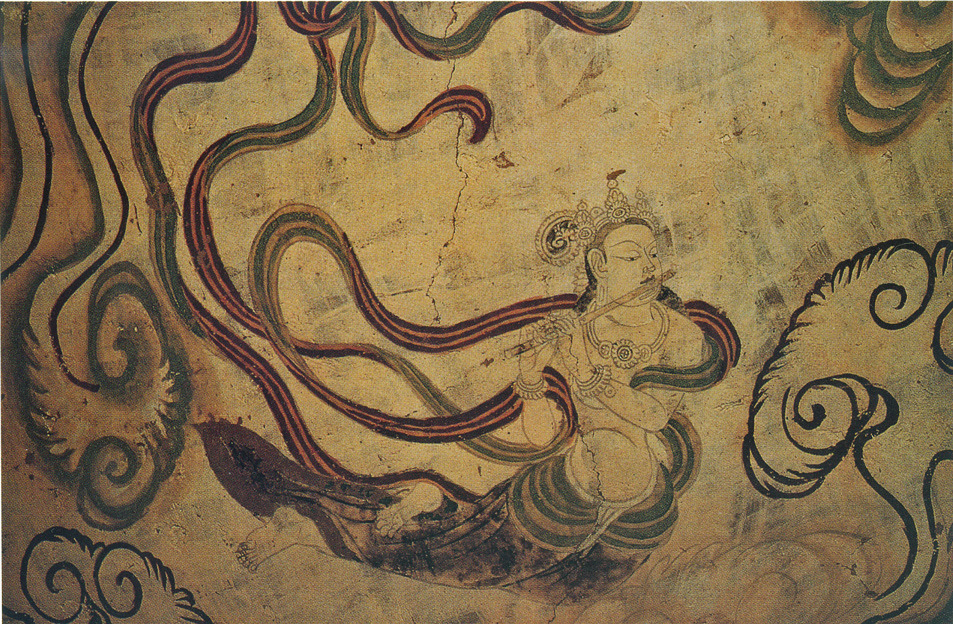
I’ve known some of their sisters, such as the ethereal Tang and Song creations of Dunhuang, who flutter around the ceilings and in the high corners of the Buddhist caves, like moths trying to find a way out to freedom but endlessly drawn back to the bright lights within. Then there are the wild naked girls of Tantric lore, dancing with their ash-smeared bodies and raggedy hair in cremation grounds, drinking blood from human skulls. In Japanese art they are mostly found sitting sedately on clouds, but in Korea they float, playing music or making offerings. In Cambodia, they most definitely dance, with wide legs and naked breasts, and irrepressible joy.
The ancient Khmers, who seemed to especially celebrate feminine beauty, decorated their temples with thousands of small apsara figures. In Angkor they play second fiddle (sorry, couldn’t resist) to their stately cousins, the devatas, who are representatives of goddesses, and guardians of the temples. These are the true queens of the Khmer ruins, some almost human size, flanking portals and adorning walls, dressed elaborately in brocaded skirts and wearing wonderfully intricate hairstyles and headdresses.
In Angkor Wat, to name just one of dozens of temples in the region, the diligent observer can find almost two thousand devatas, each with individual expressions and hand postures, all beautiful and calm. Some have faint Mona Lisa smiles; others look dreamy and coy, as though thinking of something delightful.
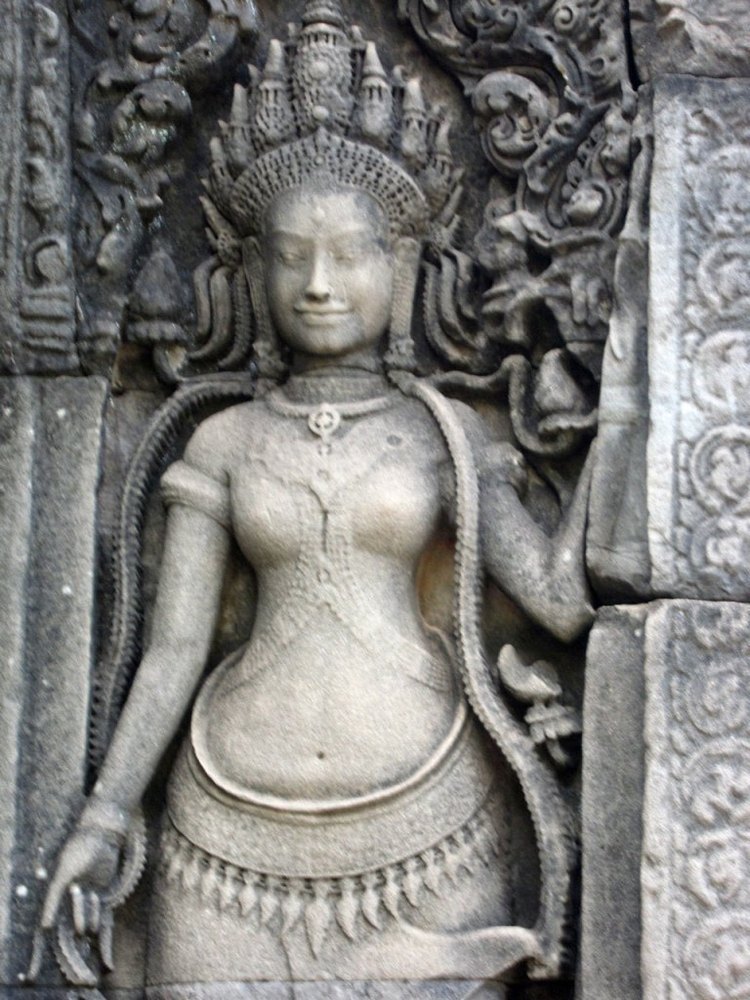
The devatas stand in elegant, slightly formal poses, weighed down by their elaborate costumes perhaps, but the Apsaras dance freely. With swinging hips and outstretched hands they sway and strut, knees bent, one leg raised, toes and fingers arching back. They wear short skirts and intricate headdresses, with bells on their ankles and jingling ornaments in their hair − if they hadn’t been frozen, captured in stone, you would swear that all of Angkor would tinkle with the sounds of thousands of tiny bells.
How marvellous it would have been to have seen Angkor at the height of its power, when these temples had gold and bronze towers, golden lions and gilded statues of gods, and gaily painted facades, and the models of the stone devatas and apsaras walked in the streets! A French researcher, Sappho Marchal, who carefully documented many hundreds of the female figures at Angkor Wat in 1927, each with a different hairstyle, facial expression and ornaments, hypothesised that they depicted the fashion of the women at the time. Other researchers think that the distinct faces of these elegant ladies represent women who lived in this great, cosmopolitan city from different groups: Cambodian, Chinese, Lao, Cham, Thai.
When Chinese emissaries visited in the 13th century, they described the hairstyles and fine embroidered cloth skirts worn by the bare breasted men and women, and hundreds of dancing girls making food offerings to deities. At that time up to a million people lived in the wealthy city, supported by ingenious hydro-engineering schemes, making it one of the largest metropolises in the world – London had a population of only about 50,000 then. Around the same time Marco Polo was visiting China, and described Hangzhou as “without doubt the finest and most splendid city in the world”. However reluctantly, the Chinese emissaries must have felt that the Angkorian capital, with all its gold and bronze, magnificent decoration, and finely figured people may well rival their own civilisation.
Now, though the stones are mostly black, and many of them sadly jumbled and thrown about by careless trees, there is still plenty of delicate work to be admired. Hundreds of metres of bas-reliefs tell historical sagas and religious tales, giant faces gaze down from pillars and gates … and all around, those sweet celestial girls dance.
Khmer apsaras like to dance at the base of columns, as if to laugh at and belittle the great weights they support, or in the background of lintels and door panels. There is a particularly fine collection of them on the pillars as you approach the outer gallery of Bayon. Captured in a moment of high-spirited movement, these delicately carved images have somehow escaped damage during the long centuries since they were placed there, looking as fresh and as lively as they did, perhaps, in the 12th century. Although the golden towers and rich fittings are gone, it is hard to imagine the pillar maidens could ever have looked more beautiful. To see them is to celebrate life: a triumph of youth and grace over time.
No less moving are the ones that have weathered, in the heartbreakingly tumbledown temples that had been devoured by jungle. In temples less visited I found them among the stones, sometimes upside down or obscured, but no less merry in form. These sweet girls, unprotected from a thousand tropical summers, are soft shadows of their former selves. They never look old or decrepit, but seem to somehow slip away before your eyes, stealing slowly back into the depths of their stones. Back in time, back to their golden age … who can begrudge their leaving, after holding these poses, so long unapplauded, in the murk of the jungle?
By Tracey Rohrsheimin Cambodia, South East AsiaFebruary 26, 2012
[ The rest is omitted.]
===================================================
===================================================


===================================================
===================================================
Google Ad
===================================================
===================================================
https://youtu.be/KsDGDzwuQ-I
Angkor Wat: City Of The God Kings
(Ancient Civilisations Documentary) | Timeline
https://youtu.be/KsDGDzwuQ-I
Published on Jul 15, 2017
Lost Worlds investigates the very latest archaeological finds at three remote and hugely significant sites - Angkor Wat, Troy and Persepolis.
Lost Worlds travels to each site and through high-end computer graphics, lavish re-enactment and the latest archaeological evidence brings them to stunning televisual life. From the 900-year-old remains of Angkor Wat in the Cambodian jungle the staggering City of the God Kings is recreated. From Project Troia, in North West Turkey, the location of the biggest archaeological expedition ever mounted the lost city is stunningly visualised and finally from Persepolis the city and the great Persian Empire are brought to life.
Content licensed from Digital Rights Group (DRG).
Produced by Darlow Smithson Productions.
Category Education
License Standard YouTube License
~~~~~~~~~~~~~~~~~~~~~~~~~~~~
☆NOTE
1." Angkor Wat " :Wikipedia
https://en.wikipedia.org/wiki/Angkor_Wat
Abstract:
Angkor Wat (Khmer: អង្គរវត្ត or "Capital Temple") is a temple complex in Cambodia and the largest religious monument in the world, on a site measuring 162.6 hectares (1,626,000 m2; 402 acres).[1] It was originally constructed as a Hindu temple of god Vishnu for the Khmer Empire, gradually transforming into a Buddhist temple towards the end of the 12th century.[2] It was built by the Khmer King Suryavarman II[3] in the early 12th century in Yaśodharapura (Khmer: យសោធរបុរៈ, present-day Angkor), the capital of the Khmer Empire, as his state temple and eventual mausoleum. Breaking from the Shaiva tradition of previous kings, Angkor Wat was instead dedicated to Vishnu. As the best-preserved temple at the site, it is the only one to have remained a significant religious centre since its foundation. The temple is at the top of the high classical style of Khmer architecture. It has become a symbol of Cambodia,[4] appearing on its national flag, and it is the country's prime attraction for visitors.[5]
By Charles J Sharp - Taken from helicopter flying over Angkor Wat, CC BY 2.5, https://commons.wikimedia.org/w/index.php?curid=1317127
2." Apsara Angkor Wat " :Google Seach
https://www.google.co.jp/search?q=apsara+angkor+wat&rlz=1C1NHXL_jaJP727JP728&tbm=isch&tbo=u&source=univ&sa=X&ved=0ahUKEwi09fiX1vnVAhWGxbwKHWurDGIQsAQIZA&biw=1745&bih=864#imgrc=XloPXlKYQB5CgM:
~~~~~~~~~~~~~~~~~~~~~~~~~~~~
~~~~~~~~~~~~~~~~~~~~~~~~~~~~
Reference
Apsara - one of thousands of unique carvings of
khmer dancing girls in Angkor Wat, Cambodia, stock photo

上記画像の出典リンク:
https://www.colourbox.com/image/apsara-one-of-thousands-of-unique-carvings-of-khmer-dancing-girls-in-angkor-wat-cambodia-image-3429870
~~~~~~~~~~~~~~~~~~~~~~~~~~~~
Hunting Apsaras through the Heat and Dust
The source Link:
https://traceyrohrsheim.com/tag/apsara/
[ Following extract ]
Hunting Apsaras through the Heat and Dust

Angkor Wat apsara trio
Of course, they are everywhere in Cambodia. Apsara hotels, apsara restaurants, apsara bookshops, hair salons, spas, art galleries, cafes.
Even the Cambodian government body looking after Angkor heritage sites is called APSARA (Authority for the Protection and Management of Angkor and the Region of Siem Reap). An apsara features on the logo of the Cambodian People’s Party. And all over the country thousands of statues, in bronze, stone, wood and even chocolate, march along shelves in every market. It is a name, an idea to capture the imagination.
They are beautiful, magical creatures. Apsaras are celestial dancing girls, born of clouds and water. Perhaps from the Churning of the Sea of Milk, or perhaps created in various other magical ways, such as from the thigh of a sage. They are handmaidens in Indra’s court (Hindu tradition), and the consorts of heavenly musicians. First mentioned in Iron Age Hindu poems (Rig-Veda 1700 BC), they appear in many stories, slipping into Buddhist tales too, turning up all over Asia, from Indonesia to Japan. Apsaras dance and play music, they fly and float on clouds. Sometimes they act as muses, or valkyries, or are sent to test the resolve of holy men. Or to teach and protect. We might call them angels, nymphs, or houris.

Mid Tang apsara in Yulin, China
I’ve known some of their sisters, such as the ethereal Tang and Song creations of Dunhuang, who flutter around the ceilings and in the high corners of the Buddhist caves, like moths trying to find a way out to freedom but endlessly drawn back to the bright lights within. Then there are the wild naked girls of Tantric lore, dancing with their ash-smeared bodies and raggedy hair in cremation grounds, drinking blood from human skulls. In Japanese art they are mostly found sitting sedately on clouds, but in Korea they float, playing music or making offerings. In Cambodia, they most definitely dance, with wide legs and naked breasts, and irrepressible joy.
The ancient Khmers, who seemed to especially celebrate feminine beauty, decorated their temples with thousands of small apsara figures. In Angkor they play second fiddle (sorry, couldn’t resist) to their stately cousins, the devatas, who are representatives of goddesses, and guardians of the temples. These are the true queens of the Khmer ruins, some almost human size, flanking portals and adorning walls, dressed elaborately in brocaded skirts and wearing wonderfully intricate hairstyles and headdresses.
In Angkor Wat, to name just one of dozens of temples in the region, the diligent observer can find almost two thousand devatas, each with individual expressions and hand postures, all beautiful and calm. Some have faint Mona Lisa smiles; others look dreamy and coy, as though thinking of something delightful.

Bayon Devata
The devatas stand in elegant, slightly formal poses, weighed down by their elaborate costumes perhaps, but the Apsaras dance freely. With swinging hips and outstretched hands they sway and strut, knees bent, one leg raised, toes and fingers arching back. They wear short skirts and intricate headdresses, with bells on their ankles and jingling ornaments in their hair − if they hadn’t been frozen, captured in stone, you would swear that all of Angkor would tinkle with the sounds of thousands of tiny bells.
How marvellous it would have been to have seen Angkor at the height of its power, when these temples had gold and bronze towers, golden lions and gilded statues of gods, and gaily painted facades, and the models of the stone devatas and apsaras walked in the streets! A French researcher, Sappho Marchal, who carefully documented many hundreds of the female figures at Angkor Wat in 1927, each with a different hairstyle, facial expression and ornaments, hypothesised that they depicted the fashion of the women at the time. Other researchers think that the distinct faces of these elegant ladies represent women who lived in this great, cosmopolitan city from different groups: Cambodian, Chinese, Lao, Cham, Thai.
When Chinese emissaries visited in the 13th century, they described the hairstyles and fine embroidered cloth skirts worn by the bare breasted men and women, and hundreds of dancing girls making food offerings to deities. At that time up to a million people lived in the wealthy city, supported by ingenious hydro-engineering schemes, making it one of the largest metropolises in the world – London had a population of only about 50,000 then. Around the same time Marco Polo was visiting China, and described Hangzhou as “without doubt the finest and most splendid city in the world”. However reluctantly, the Chinese emissaries must have felt that the Angkorian capital, with all its gold and bronze, magnificent decoration, and finely figured people may well rival their own civilisation.
Now, though the stones are mostly black, and many of them sadly jumbled and thrown about by careless trees, there is still plenty of delicate work to be admired. Hundreds of metres of bas-reliefs tell historical sagas and religious tales, giant faces gaze down from pillars and gates … and all around, those sweet celestial girls dance.
Bayon apsaras
Khmer apsaras like to dance at the base of columns, as if to laugh at and belittle the great weights they support, or in the background of lintels and door panels. There is a particularly fine collection of them on the pillars as you approach the outer gallery of Bayon. Captured in a moment of high-spirited movement, these delicately carved images have somehow escaped damage during the long centuries since they were placed there, looking as fresh and as lively as they did, perhaps, in the 12th century. Although the golden towers and rich fittings are gone, it is hard to imagine the pillar maidens could ever have looked more beautiful. To see them is to celebrate life: a triumph of youth and grace over time.
No less moving are the ones that have weathered, in the heartbreakingly tumbledown temples that had been devoured by jungle. In temples less visited I found them among the stones, sometimes upside down or obscured, but no less merry in form. These sweet girls, unprotected from a thousand tropical summers, are soft shadows of their former selves. They never look old or decrepit, but seem to somehow slip away before your eyes, stealing slowly back into the depths of their stones. Back in time, back to their golden age … who can begrudge their leaving, after holding these poses, so long unapplauded, in the murk of the jungle?
Bayon fading apsara
By Tracey Rohrsheimin Cambodia, South East AsiaFebruary 26, 2012
[ The rest is omitted.]
===================================================
===================================================
===================================================
===================================================
Google Ad
===================================================
===================================================
Robam Tep Apsara_របាំទេពអប្សរា
Robam Tep Apsara_របាំទេពអប្សរា
https://youtu.be/mkwR7l-fCcQ
Published on Aug 10, 2010
Khmer Classical Dance Robam Tep Apsara by Royal Production and Capital dancing troupe, dedicated to Miss. Touch Sunnix,singer and teacher of Khmer classical dance. (Full HD 14 minutes long)
Royal Production DVD Vol 19 Chapter 20
Category Entertainment
License Standard YouTube License
~~~~~~~~~~~~~~~~~~~~~~~~~~~~
☆NOTE
" Apsara " :Wikipedia
https://en.wikipedia.org/wiki/Apsara
===================================================
===================================================


===================================================
===================================================
https://youtu.be/mkwR7l-fCcQ
Published on Aug 10, 2010
Khmer Classical Dance Robam Tep Apsara by Royal Production and Capital dancing troupe, dedicated to Miss. Touch Sunnix,singer and teacher of Khmer classical dance. (Full HD 14 minutes long)
Royal Production DVD Vol 19 Chapter 20
Category Entertainment
License Standard YouTube License
~~~~~~~~~~~~~~~~~~~~~~~~~~~~
☆NOTE
" Apsara " :Wikipedia
https://en.wikipedia.org/wiki/Apsara
===================================================
===================================================
===================================================
===================================================
Cambodian Dance: Dance of the Apsara Divinities
Cambodian Dance: Dance of the Apsara Divinities
https://youtu.be/_EH9KeIvQpk
Cambodian Dance: Dance of the Apsara Divinities
https://youtu.be/_EH9KeIvQpk
Published on Jun 15, 2015
Cambodian-American Heritage, Inc. Dancers (Featuring Devi Yim Dos as head Apsara dancer; ivory skirt, center). From left to right (at beginning): Lynna Lam, Suteera Nagavajara, Kalyaney Sokhon, Tevy Chao.)
Performance for Asia Society, Spring 2010
Washington, DC (see www.cambodianheritage.org for more information)
Category News & Politics
License Standard YouTube License
~~~~~~~~~~~~~~~~~~~~~~~~~~~~
☆NOTE
" Apsara " :Wikipedia
https://en.wikipedia.org/wiki/Apsara
===================================================
===================================================


===================================================
===================================================
https://youtu.be/_EH9KeIvQpk
Cambodian Dance: Dance of the Apsara Divinities
https://youtu.be/_EH9KeIvQpk
Published on Jun 15, 2015
Cambodian-American Heritage, Inc. Dancers (Featuring Devi Yim Dos as head Apsara dancer; ivory skirt, center). From left to right (at beginning): Lynna Lam, Suteera Nagavajara, Kalyaney Sokhon, Tevy Chao.)
Performance for Asia Society, Spring 2010
Washington, DC (see www.cambodianheritage.org for more information)
Category News & Politics
License Standard YouTube License
~~~~~~~~~~~~~~~~~~~~~~~~~~~~
☆NOTE
" Apsara " :Wikipedia
https://en.wikipedia.org/wiki/Apsara
===================================================
===================================================
===================================================
===================================================
2017年08月27日
APSARA DANCE Cambodia
APSARA DANCE Cambodia
https://youtu.be/IezDuqfJdn0
APSARA DANCE Cambodia
https://youtu.be/IezDuqfJdn0
Published on Mar 29, 2013
No visit to Cambodia is complete without attending at least one traditional Khmer dance performance, often referred to as 'Apsara Dance' after one of the most popular Classical dance pieces. Traditional Khmer dance is better described as 'dance-drama' in that the dances are not merely dance but are also meant to convey a story or message. There are four main modern genres of traditional Khmer dance: 1) Classical Dance, also known as Court or Palatine Dance (lakhon preah reach troap or lakhon luong); 2) Shadow theater (sbeik thom and sbeik toot); 3) Lakhon Khol (all-male masked dance-drama.); 4) Folk Dance (Ceremonial and Theatrical).
As evidenced in part by the innumerable apsaras (celestial dancers) that adorn the walls of Angkorian and pre-Angkorian temples, dance has been part of Khmer culture for well more than a millennium, though there have been ruptures in the tradition over the centuries, making it impossible to precisely trace the source of the tradition. Much of traditional dance (especially Classical) is inspired by Angkorian-era art and themes, but the tradition has not been passed unbroken from the age of Angkor. Most traditional dances seen today were developed in the 18th through 20th centuries, beginning in earnest with a mid-19th century revival championed by King Ang Duong (reigned 1841-1869). Subsequent Kings and other Khmer Royals also strongly supported the arts and dance, most particularly Queen Sisowath Kossamak Nearireach (retired King Norodom Sihanouk's mother) in the mid-20th century, who not only fostered a resurgence in the study and development of Khmer traditional dance, but also helped move it out of the Palace and popularize it.
Classical dance, including the famous 'Apsara dance,' has a grounded, subtle, even restrained, yet feather-light, ethereal appearance. Distinct in its ornate costuming, taut posture, arched back and feet, fingers flexed backwards, codified facial expressions, slow, close, deliberate but flowing movements, Classical dance is uniquely Khmer. It presents themes and stories inspired primarily by the Reamker (the Cambodian version of the Indian classic, the Ramayana) and the Age of Angkor.
The Apsara Dance is a Classical dance inspired by the apsara carvings and sculptures of Angkor and developed in the late 1940s by Queen Sisowath Kossamak. Her grand daughter and protégé, Princess Bopha Devi, was the first star of the Apsara Dance. The central character of the dance, the apsara Mera, leads her coterie of apsaras through a flower garden where they partake of the beauty of the garden. The movements of the dance are distinctly Classical yet, as the dance was developed for theatrical presentation, it is shorter and a bit more relaxed and flowing than most Classical dances, making it both an excellent example of the movements, manner and spirit of Classical dance and at the same time particularly accessible to a modern audience unaccustomed to the style and stories of Khmer dance-drama.
Category Travel & Events
License Standard YouTube License
~~~~~~~~~~~~~~~~~~~~~~~~~~~~
☆NOTE
" Apsara " :Wikipedia
https://en.wikipedia.org/wiki/Apsara
===================================================
Khmer Classical Dance_Robam Choun Por_របាំជូនពរ
https://youtu.be/TUqp6uhlzoE
Khmer Classical Dance_Robam Choun Por_
របាំជូនពរ
https://youtu.be/TUqp6uhlzoE
NOTE:リクエストによる埋め込み無効
===================================================
===================================================


===================================================
===================================================
https://youtu.be/IezDuqfJdn0
APSARA DANCE Cambodia
https://youtu.be/IezDuqfJdn0
Published on Mar 29, 2013
No visit to Cambodia is complete without attending at least one traditional Khmer dance performance, often referred to as 'Apsara Dance' after one of the most popular Classical dance pieces. Traditional Khmer dance is better described as 'dance-drama' in that the dances are not merely dance but are also meant to convey a story or message. There are four main modern genres of traditional Khmer dance: 1) Classical Dance, also known as Court or Palatine Dance (lakhon preah reach troap or lakhon luong); 2) Shadow theater (sbeik thom and sbeik toot); 3) Lakhon Khol (all-male masked dance-drama.); 4) Folk Dance (Ceremonial and Theatrical).
As evidenced in part by the innumerable apsaras (celestial dancers) that adorn the walls of Angkorian and pre-Angkorian temples, dance has been part of Khmer culture for well more than a millennium, though there have been ruptures in the tradition over the centuries, making it impossible to precisely trace the source of the tradition. Much of traditional dance (especially Classical) is inspired by Angkorian-era art and themes, but the tradition has not been passed unbroken from the age of Angkor. Most traditional dances seen today were developed in the 18th through 20th centuries, beginning in earnest with a mid-19th century revival championed by King Ang Duong (reigned 1841-1869). Subsequent Kings and other Khmer Royals also strongly supported the arts and dance, most particularly Queen Sisowath Kossamak Nearireach (retired King Norodom Sihanouk's mother) in the mid-20th century, who not only fostered a resurgence in the study and development of Khmer traditional dance, but also helped move it out of the Palace and popularize it.
Classical dance, including the famous 'Apsara dance,' has a grounded, subtle, even restrained, yet feather-light, ethereal appearance. Distinct in its ornate costuming, taut posture, arched back and feet, fingers flexed backwards, codified facial expressions, slow, close, deliberate but flowing movements, Classical dance is uniquely Khmer. It presents themes and stories inspired primarily by the Reamker (the Cambodian version of the Indian classic, the Ramayana) and the Age of Angkor.
The Apsara Dance is a Classical dance inspired by the apsara carvings and sculptures of Angkor and developed in the late 1940s by Queen Sisowath Kossamak. Her grand daughter and protégé, Princess Bopha Devi, was the first star of the Apsara Dance. The central character of the dance, the apsara Mera, leads her coterie of apsaras through a flower garden where they partake of the beauty of the garden. The movements of the dance are distinctly Classical yet, as the dance was developed for theatrical presentation, it is shorter and a bit more relaxed and flowing than most Classical dances, making it both an excellent example of the movements, manner and spirit of Classical dance and at the same time particularly accessible to a modern audience unaccustomed to the style and stories of Khmer dance-drama.
Category Travel & Events
License Standard YouTube License
~~~~~~~~~~~~~~~~~~~~~~~~~~~~
☆NOTE
" Apsara " :Wikipedia
https://en.wikipedia.org/wiki/Apsara
===================================================
Khmer Classical Dance_Robam Choun Por_របាំជូនពរ
https://youtu.be/TUqp6uhlzoE
Khmer Classical Dance_Robam Choun Por_
របាំជូនពរ
https://youtu.be/TUqp6uhlzoE
NOTE:リクエストによる埋め込み無効
===================================================
===================================================
===================================================
===================================================


